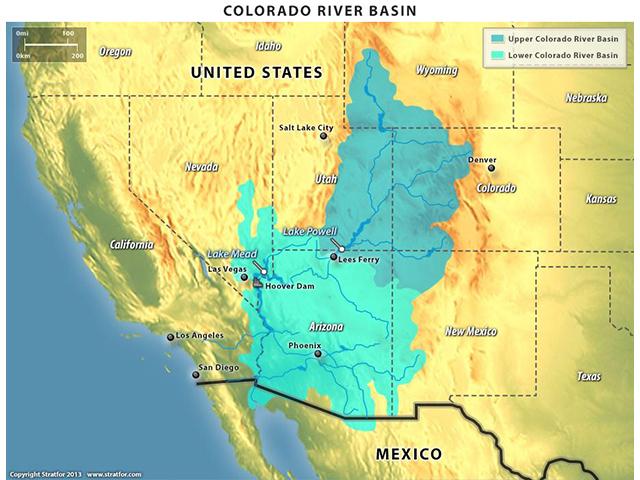The agreement was the result of months of negotiation, the according to the governors of California, Nevada and Arizona...the state leaders acknowledged in a joint press release that the work isn't over with this agreement and the threats to the Colorado River will continue past 2026.
 Figure 18. Historical and projected water use and demand along the Colorado River.
Figure 18. Historical and projected water use and demand along the Colorado River.
Source: U.S. Bureau of Reclamation Colorado River Factsheet.
- The vast amount of water conservation will take place in exchange for about $1 billion in federal funding.
- The Interior Department has pledged $281 million for 21 water recycling projects, up to $233 million in water conservation funding for the Gila River Indian Community, more than $73 million for infrastructure repairs on water delivery systems, $71 million for 32 drought resiliency projects to expand access to water through groundwater storage, rainwater harvesting, aquifer recharge and water treatment and $20 million in new small surface and groundwater storage investments.
US states agree breakthrough deal to prevent Colorado River from drying up
California, Arizona and Nevada strike deal with US government to take about 13% less water from drought-stricken river
"A deal has been struck by Joe Biden’s administration for California, Arizona and Nevada to take less water from the drought-stricken Colorado River, in a bid to prevent the river dwindling further and imperiling the water supplies for millions of people and vast swaths of agricultural land in the US west.
The agreement, announced on Monday, will involve the three states, water districts, Native American tribes and farm operators cutting about 13% of the total water use in the lower Colorado basin, a historic reduction that will probably trigger significant water restrictions on the region’s residents and farmland. . .The agreement averts, for now, the prospect of the Biden administration imposing unilateral water cuts upon the seven states – California, Arizona, Nevada, Colorado, New Mexico, Utah and Wyoming – that rely upon the river, a prospect that has loomed since last summer when the waterway’s two main reservoirs, Lake Mead and Lake Powell, hit perilously low levels.
“Today’s announcement is a testament to the Biden-Harris administration’s commitment to working with states, tribes and communities throughout the west to find consensus solutions in the face of climate change and sustained drought,” said Deb Haaland, the US interior secretary.
Harnessing the might of the Colorado river, which rises in the Rocky mountains and flows all the way to Mexico, has enabled cities such as Los Angeles, Phoenix and Las Vegas to flourish, as well as allowing millions of acres of agricultural land to be cultivated in otherwise harsh desert environments. More than 40m people rely upon the water the 1,450-mile river provides.
But the enormous extraction of water, mainly for farming, coupled with the climate crisis, which has increased the evaporation of water and reduced the snowpack that feeds the river, has caused a crisis point for the river and US west. The region is experiencing its worst drought in 1,200 years, with this year’s bumper rain and snowfall not expected to fully release the grip of a two-decade “megadrought”.
. . .Any further drop – Lake Mead is only about a third full and is at its lowest ebb since the construction of the Hoover Dam, which created it – could see the drying up of the Colorado river south of the reservoir, which feeds the lower basin states – Nevada, California and Arizona."
LINK: The Guardian
RELATED
Sizing up Colorado River Water Fight
Arizona Farms' Crop Choices at Center of Colorado River Basin Water Dispute
The Colorado River Compact
The Colorado River flows almost 1500 km from its headwaters in Wyoming, Colorado, Utah and New Mexico, through Nevada, Arizona, and California, before crossing the border to Mexico and flowing to the Gulf of California. It is the lifeblood of the American Southwest, serving almost 30 million people and enabling cities, industry, and irrigation-based agriculture to thrive in one of the direst climates on Earth (see Figure 1 in Module 8.2). The river also provides hydroelectric power that spurred much of the 20th century development of the Southwestern U.S.
In 1922, these seven western states and the federal government negotiated an agreement, the Colorado River Compact (Figure 15) to allocate water rights on the river. First and foremost the compact partitioned water between Utah, New Mexico, Wyoming, and Colorado (the Upper Basin States) where most of its discharge originates as snowmelt); and Arizona, Nevada, and California (the Lower Basin States), where population growth and water demand were increasing rapidly (Figure 16).
LINK: Materials
X


No comments:
Post a Comment